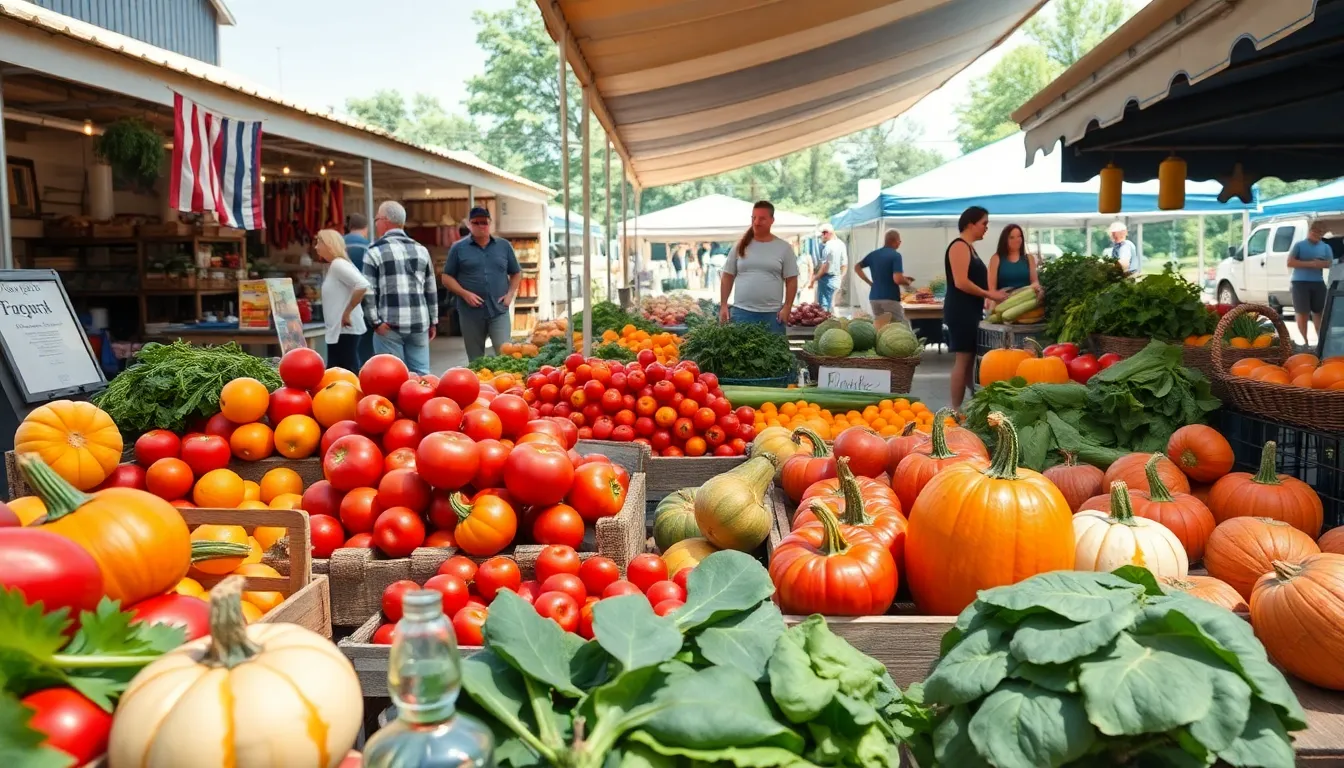As the seasons change, so do the ingredients available for cooking. Embracing seasonal produce not only enhances flavor but also supports local farmers and reduces the carbon footprint. Knowing how to navigate these seasonal shifts can elevate any home cook’s game.
Seasonal cooking hacks can transform everyday meals into delightful culinary experiences. From preserving summer fruits to utilizing hearty winter vegetables, these tips and tricks make it easy to enjoy fresh, vibrant dishes year-round. Whether it’s quick prep techniques or creative storage ideas, mastering seasonal cooking opens the door to a world of flavor and nutrition. Dive into the art of cooking with the seasons and discover how simple adjustments can lead to delicious results.
Table of Contents
ToggleImportance Of Seasonal Cooking
Seasonal cooking offers numerous advantages that enhance both culinary and lifestyle choices.
- Flavor Enhancement: Seasonal ingredients taste better due to optimal growing conditions. Fresh produce harvested at its peak provides richer flavors in dishes.
- Support for Local Farmers: Purchasing seasonal ingredients often means buying from local farmers. Supporting local agriculture boosts the economy and fosters community relationships.
- Reduction of Environmental Impact: Seasonal cooking minimizes carbon footprints. Foods grown locally require less transportation, reducing greenhouse gas emissions associated with long-distance shipping.
- Nutritional Benefits: Seasonal ingredients retain more nutrients. They’re typically harvested at their ripest state, offering maximum nutritional value compared to out-of-season produce.
- Cost-Effectiveness: Seasonal items are often more affordable. Increased availability leads to lower prices, making healthy eating more accessible.
- Culinary Variety: Seasonal cooking opens opportunities for trying new flavors. Each season brings different fruits and vegetables, encouraging creative preparation methods.
- Preservation Skills: Mastering seasonal cooking improves preservation techniques. Learning to can or freeze seasonal items allows for enjoyment throughout the year.
Embracing seasonal cooking cultivates a deeper appreciation for food and its sources, leading to healthier choices and satisfying meals.
Benefits Of Seasonal Cooking Hacks


Seasonal cooking hacks offer several advantages that improve culinary experiences and support local communities. They enhance freshness, flavor, and cost-effectiveness while contributing to healthier eating habits.
Freshness And Flavor
Using seasonal ingredients ensures dishes contain the freshest produce available, which translates to superior flavor. Local farmers harvest items at peak ripeness, maximizing taste and nutrient content. For example, tomatoes picked in late summer exhibit exceptional juiciness and sweetness compared to out-of-season counterparts shipped long distances. Enhanced freshness means meals can showcase the vibrant flavors and textures that seasonal cooking provides, transforming ordinary dishes into culinary delights.
Cost-Effectiveness
Seasonal ingredients often come at lower prices due to larger harvests and reduced transportation costs. Grocery stores and farmers’ markets frequently offer sales on items that are in abundance, making it financially wise for consumers. For instance, buying pumpkins in the fall typically costs less than sourcing them during the spring months. This cost-effectiveness not only benefits individual budgets but also encourages purchasing from local farmers, stimulating local economies. Embracing these seasonal deals allows cooks to create delicious meals without straining their finances.
Essential Seasonal Ingredients
Seasonal ingredients vary by time of year, offering unique flavors and nutritional benefits. Utilizing them enhances cooking experiences and connects consumers to local agriculture.
Spring Produce
Spring brings a bounty of fresh vegetables and herbs, including asparagus, peas, and radishes. Asparagus appears from late March through May, yielding tender spears perfect for roasting or grilling. Snap peas offer a sweet crunch in salads, while radishes add a peppery bite. Other notable ingredients include spinach and leeks, with spinach peaking in April and May for vibrant salads or sautés. These seasonal items provide essential vitamins and minerals, fostering health and flavor in dishes.
Summer Fruits
Summer showcases an array of juicy fruits, such as berries, peaches, and melons. Strawberries, often ready by late May, burst with sweetness, enhancing desserts and salads. Peaches, available from June to August, bring natural sweetness for grilling or snacking. Watermelon, popular during summer months, offers refreshing hydration, perfect in salads or smoothies. Seasonal fruits not only taste exceptional but also supply antioxidants and vitamins, promoting overall wellness.
Fall Vegetables
Fall introduces hearty vegetables that thrive in cooler temperatures, including pumpkins, squash, and Brussels sprouts. Pumpkins emerge in late September, ideal for soups and pies. Butternut squash, becoming popular in October, lends a creamy texture to various dishes. Brussels sprouts, in season from October to March, provide a nutty flavor, especially when roasted. These vegetables are rich in fiber and vitamins, supporting healthy eating throughout the season.
Winter Staples
Winter staples focus on root vegetables and storage crops, such as carrots, potatoes, and cabbage. Carrots, available year-round but especially sweet in winter, add color and nutrient density to meals. Potatoes supply versatility, with varieties like russet and sweet potatoes offering different flavors and culinary uses. Cabbage shines in winter, perfect for salads, slaws, or braised dishes. These hardy ingredients maintain nutritional value, making them essential for comforting winter meals.
Creative Seasonal Cooking Hacks
Seasonal cooking hacks enhance culinary creativity and efficiency. Implementing these strategies maximizes the use of fresh, local ingredients while allowing for quick, flavorful meals.
Quick Meal Prep Tips
- Plan Weekly Menus: Design menus around seasonal ingredients to streamline shopping and cooking.
- Batch Cook: Prepare larger portions of soups or stews featuring seasonal produce. Freeze leftovers for easy access during busy weeks.
- Use One-Pot Recipes: Simplify cleanup with one-pot dishes that showcase seasonal vegetables, like ratatouille or vegetable stir-fry.
- Cut and Store: Pre-chop seasonal vegetables and store them in airtight containers for rapid meal assembly.
- Mix and Match: Combine seasonal ingredients in versatile recipes, such as grain bowls, allowing for customized meals based on available produce.
Preserving Seasonal Ingredients
- Canning Techniques: Utilize canning for summer fruits, like peaches and tomatoes, to enjoy their flavors year-round. Follow safety guidelines to ensure quality preservation.
- Freezing Essentials: Freeze seasonal vegetables, such as green beans or corn, soon after harvest. This maintains nutrient content and flavor.
- Herb Infusions: Create herb-infused oils or vinegars with fresh seasonal herbs, extending their usability and adding flavor to dishes.
- Pickling: Transform cucumbers, radishes, or other veggies into pickles. Use vinegar and spices for a zesty addition to meals.
- Dehydration: Dehydrate fruits like apples or pears for snacks or baking. Proper dehydration techniques retain essential vitamins and add convenience.
Embracing seasonal cooking opens up a world of flavor and nutrition. By incorporating fresh, local ingredients into daily meals, individuals not only enhance their culinary experiences but also contribute to their communities and the environment. The hacks shared throughout this article empower home cooks to make the most of each season’s bounty.
With a little creativity and planning, seasonal cooking becomes an enjoyable and rewarding practice. It encourages exploration of diverse flavors while ensuring meals remain both nutritious and cost-effective. As seasons change, so too can the culinary adventures, leading to healthier choices and a deeper appreciation for the food we consume.



